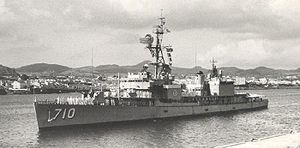- Gearing class destroyer
-

USS Gearing (DD-710)Class overview Name: Gearing class destroyer Builders: Bath Iron Works
Bethlehem Steel, Fore River ShipyardOperators:  United States Navy
United States Navy
 Republic of China Navy (Taiwan)
Republic of China Navy (Taiwan)
 Hellenic Navy
Hellenic Navy
 Republic of Korea Navy
Republic of Korea Navy
 Spanish Navy
Spanish Navy
 Turkish Navy
Turkish Navy
 Pakistan Navy
Pakistan Navy
 Argentine Navy
Argentine Navy
 Brazilian Navy
Brazilian Navy
 Mexican Navy
Mexican Navy
 Ecuadorian Navy
Ecuadorian Navy
 Islamic Republic of Iran Navy
Islamic Republic of Iran NavyPreceded by: Allen M. Sumner-class destroyer Succeeded by: Mitscher-class destroyer Planned: 152 Completed: 98 Cancelled: 7 Retired: 98 Preserved: 2 General characteristics as originally built Type: Destroyer Displacement: 2,616 tons standard; 3,460 tons full load Length: 390.5 ft (119.0 m) Beam: 40.9 ft (12.5 m) Draft: 14.3 ft (4.4 m) Propulsion: 2 shaft; General Electric steam turbines; 4 boilers; 60,000 shp Speed: 36.8 knots (68.2 km/h) Range: 4,500 nmi at 20 knots
(8,300 km at 37 km/h)Armament: - 6 × 5 in /38 cal guns (3×2) guided by a Mark 37 Gun Fire Control System with a Mk25 fire control radar linked by a Mark 1A Fire Control Computer stabilized by a Mk6 8,500 rpm gyro.
- 12 × 40 mm Bofors gun (2×2, 2×4)
- 16 × 20 mm Oerlikon cannon
- 10 × 21 inch torpedo tubes
The Gearing class was a group of 98 destroyers built for the US Navy during and shortly after World War II. The Gearing design was a minor modification of the immediately preceding Allen M. Sumner class. The hull was lengthened 14 ft (4.3 m) amidships, creating more storage space for fuel, thus giving the ships a larger range than the Sumners.
The first Gearings were not ready for service until mid-1945, so they saw relatively little wartime service. They continued serving, with a series of upgrades, until the 1970s. At that time many were sold to other nations, where they served many more years.
Two Gearing-class ships still exist, as museum ships: USS Joseph P. Kennedy, Jr. (DD-850) in Fall River, MA, and USS Orleck (DD-886) in Lake Charles, LA.
Contents
FRAM I upgrade
In the late 1950s forty-four of the Gearing-class destroyers underwent extensive modernization overhauls, known as FRAM I, which were designed to convert them from an AA destroyer to an anti-submarine warfare platform.
The FRAM MK I program was designed primarily for the Gearing-class destroyers. This upgrade included rebuilding the ship's superstructure, engines, electronic systems, radar, sonar, and weapons. The second twin 5" gun mount was removed. Upgraded systems include SQS-23 sonar, SPS-10 surface search radar, 2 × triple Mk 32 torpedo launchers, 8-cell ASROC box launcher, and QH-50C DASH ASW drone helicopter, with its own landing pad and hangar.[1]
The Gyrodyne QH-50C DASH was an unmanned anti-submarine helicopter, controlled remotely from the ship. The drone could carry 2 × MK.44 homing ASW torpedoes. During this era the ASROC system had an effective range of only 5 nautical miles (9 km), but the DASH drone allowed the ship to deploy ASW attack to sonar contacts as far as 22 nautical miles (41 km) away.[2]
An upgraded version of DASH, QH-50D, remained in use by the US Army until May, 2006.[3]
FRAM II upgrade
The FRAM MK II program was designed primarily for the Sumner-class destroyers, but were used to upgrade the Gearing class as well. This upgrade program includes life-extension refurbishment, a new radar system, Mk. 32 torpedo, DASH ASW drone, and most importantly, a new variable depth sonar (VDS).
Yang class
After the Gearing-class ships were retired from USN service, many were sold abroad, including over a dozen to the Republic of China Navy (ROCN) in Taiwan. These ships, along with Fletcher-class and Allen M. Sumner-class destroyers also acquired then, were upgraded under the Wu Chin I, II, and III programs and known throughout the ROCN as the Yang-class (Chinese: 陽字號) destroyers as they were assigned names that all end with the word "Yang". The last batch of 7 WC-III program vessels, all of them Gearing class, were retired in early 2000s.[4]
Under the most advanced Wu Chin III upgrade program, all World War Two vintage weapons were removed and replaced with 4 × Hsiung Feng II SSM, 10 × SM-1[disambiguation needed
 ] (box launchers), 1 × 8-cell ASROC, 1 × 76 mm gun, 2 × 40 mm/70 AA, 1 × 20 mm Phalanx CIWS and 2 × triple 12.75" torpedo tubes. The DASH ASW drones were not acquired, but hangar facilities aboard those ships that had them were later used to accommodate ASW version of Hughes MD500 helicopters.
] (box launchers), 1 × 8-cell ASROC, 1 × 76 mm gun, 2 × 40 mm/70 AA, 1 × 20 mm Phalanx CIWS and 2 × triple 12.75" torpedo tubes. The DASH ASW drones were not acquired, but hangar facilities aboard those ships that had them were later used to accommodate ASW version of Hughes MD500 helicopters.After the Yang-class destroyers were decommissioned, the SM-1 launch boxes were moved to Chi Yang-class frigates to improve their anti-air capability.
References
External links
- Gearing-class destroyers at Destroyer History Foundation
- http://www.gyrodynehelicopters.com/gearing_class.htm
United States naval ship classes of World War IIAircraft carriers Light aircraft carriers Escort carriers Battleships Large cruisers Heavy cruisers Light cruisers Destroyers Destroyer escorts Patrol frigates Minesweepers Submarines - S — Single ship of class
- C — Completed after the war
- X — Cancelled
Categories:- Destroyer classes
- Gearing class destroyers
Wikimedia Foundation. 2010.
